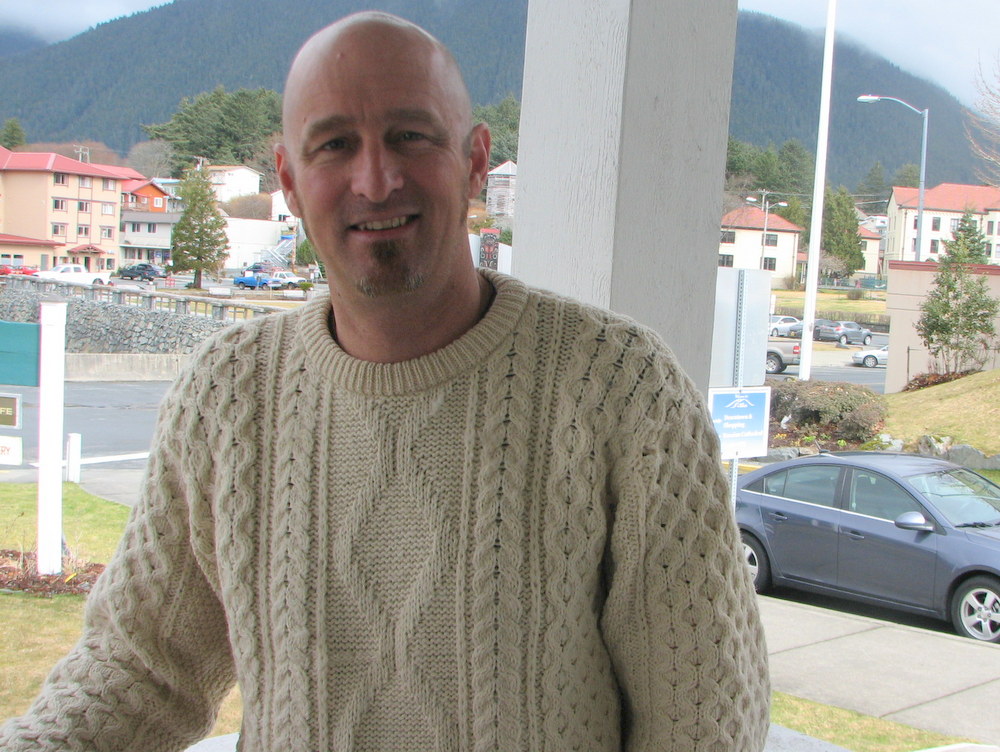
Brent Ruby, PhD, believes strategies developed in his lab for endurance athletes could benefit “occupational athletes” like commercial fishermen. (KCAW photo/Robert Woolsey)
A noted exercise physiologist from the lower 48 has been in Alaska this week updating health professionals on the latest research on the subject. He’s also been taking a look at what he calls “occupational athletes,” like commercial fishermen, and trying to find ways his research can apply to their work.
Dr. Brent Ruby will give a presentation tonight (Tue 4-9-14) on some of his research on people — like ultra-distance athletes and wildland firefighters — whose daily calorie expenditures far exceed what used to be considered normal for those activities. He’ll speak at 6 PM in the downstairs classroom at Sitka Community Hospital. The presentation is free and open to the public.
Dr. Brent Ruby is the director of the Montana Center for Work Physiology and Exercise in Missoula. But that’s not his biggest claim to fame. The guy once actually passed Frank Shorter in a race.
“It was a 5K – 30K – 5K event, and I remember coming up on him in the second 5K and going by him and thinking, This is probably one of the coolest athletic moments I’ve had.”
Frank Shorter was the first American to win the Olympic marathon, in 1972. Ruby also stayed with Kenyan great Henry Rono in a 5K race, but was “left in the dust” during the last mile.
So Ruby knows athletes, and studies athletes, but his work is relevant for the rest of us.
His latest data suggest that we don’t really understand heat exhaustion.
“There’s a misconception for athletes and individuals that, As long as I drink enough, we’ll be safe. And that is the misconception that we want to try to topple over.”
Ruby has consulted for wildland firefighters, the military, and football programs running two-a-day practices in the late summer. His lab at the University of Montana has developed monitoring tools for heat stress, and has explored ways to train for — and overcome — the hazards of working and playing in the heat.
Understanding the nature of heat stress, and disassociating it from dehydration, has been a been breakthrough. He says almost no one ever dies from dehydration. The real risk is heat.
“There has to be a balance between heat production and the ability to lose that heat. And when that gets out of balance — no matter how vigorous our hydration choices — we can’t combat the heat all the time. There are numerous examples of death due to heat stress — exertional heat stress — where the individual is completely, normally hydrated.”
Ruby says humans have an extraordinary ability to adapt and shed excess heat. But, by living in Alaska, do we give up that ability?
“You can’t take the heat, or you just don’t want to. Those are two separate things.”
Ruby says that heat tolerance — in every human — operates on a known schedule. And it’s good or bad news, depending on how enthusiastic you are about visiting relatives in the lower 48 in the summertime.
“It’s a slow process that kind of builds exponentially. The first five days or so you really start to see some rapid changes. And then over the course of a week or two weeks, all sorts of things start to change: Your ability to sweat — your actual sweat rate — can double per hour. What’s also unique is that the composition of the sweat will change, as a function of that acclimatization to the heat. So you lose less of the precious electrolyte, the more accustomed you get to being in that heat.”
A related area of study for Ruby is exertion. He’s worked to quantify the metabolic activity of not only ultra-endurance athletes, but also people he calls “occupational athletes.” Firefighters are in that category. So are Alaska’s commercial fishermen who sometimes work hard 36 to 72 hours at a stretch with little rest.
“Normal, basic human physiology is sort of programmed to really go big. And it’s fun to see individual examples of that in people who don’t make the kind of money that the tour athletes make, the well-known endurance athletes.”
And when your doctor tells you that “research shows” that exercise is good for us? That information is coming out of Ruby’s lab. He says that society has conditioned us to believe that inactivity is a privilege. It’s also a prescription for disease.
“There’s no doubt that the medicinal benefit of physical activity are enormous. And undeniable. That physical inactivity is as significant — if not more significant — than the health impacts we’ve seen from smoking. So getting people to choose to be more active, in a variety of ways — most people think it has to be so structured! — and it doesn’t have to be structured, but it can be a part of your everyday lifestyle.”
And this landlocked Montanan doesn’t just talk the talk. He builds paddle boards at home, and travels with an inflatable. He left our studios with directions to the nearest sandy beach to incorporate a little bit of surf into his lifestyle.































